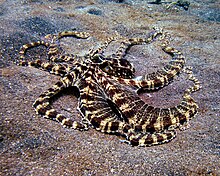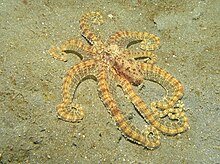The mimic octopus, Thaumoctopus mimicus, is a species of octopus that has a strong ability to mimic other creatures. It grows up to 60 cm (2 feet) in length. Its normal colouring consists of brown and white stripes or spots.
Living in the tropical seas of Southeast Asia, it was not discovered officially until 1998,[1] off the coast of Sulawesi. Recently found in the great barrier reef in Northern Queensland in 2010. The octopus mimics the physical likeness and movements of more than 15 different species, including sea snakes, lionfish, flatfish, brittle stars, giant crabs, sea shells, stingrays, flounders, jellyfish, sea anemones, and mantis shrimp.[2][3] It accomplishes this by contorting its body and arms, and changing colour.
Although all octopuses can change colour and texture, and many can blend with the sea floor, appearing as rocks, the mimic octopus is the first octopus species ever observed to impersonate other animals.[3][4]
Based on observation, the mimic octopus may decide which animal to impersonate depending on local predators. For example, when the octopus was being attacked by damselfish, the octopus was observed to appear as a banded sea snake, a damselfish predator. The octopus impersonates the snake by turning black and yellow, burying six of its arms, and waving its other two arms in opposite directions.[5]
The mimic octopus is often confused with Wunderpus photogenicus, another recently discovered species.[6] Wunderpus can be distinguished by the pattern of strong, fixed white markings on its body.[7]
| Mimic octopus | |
|---|---|
 |
|
| Scientific classification | |
| Kingdom: | Animalia |
| Phylum: | Mollusca |
| Class: | Cephalopoda |
| Order: | Octopoda |
| Family: | Octopodidae |
| Subfamily: | Octopodinae |
| Genus: | Thaumoctopus Norman & Hochberg, 2005 |
| Species: | T. mimicus |
| Binomial name | |
| Thaumoctopus mimicus Norman & Hochberg, 2005 | |
Habitat and behavior
The mimic octopus lives exclusively in nutrient-rich estuarine bays of Indonesia and Malaysia full of potential prey. It uses a jet of water through its funnel to glide over the sand while searching for prey, typically small fish, crabs, and worms. It also is prey to other species. Like other octopuses, the mimic octopus' soft body is made of nutritious muscle, without spine or armor, and not obviously poisonous, making it desirable prey for large, deep water carnivores, such as barracuda and small sharks. Often unable to escape such predators, its mimicry of different poisonous creatures serves as its best defense. Mimicry also allows it to prey upon animals that would ordinarily flee an octopus; it can imitate a crab as an apparent mate, only to devour its deceived suitor.This octopus mimics venomous sole, lion fish, sea snakes, sea anemones, and jellyfish. For example, the mimic is able to imitate a sole by pulling its arms in, flattening to a leaf-like shape, and increasing speed using a jet-like propulsion that resembles a sole. When spreading its legs and lingering on the ocean bottom, its arms trail behind to simulate the lion fish's fins. By raising all of its arms above its head with each arm bent in a curved, zig-zag shape to resemble the lethal tentacles of a fish-eating sea anemone, it deters many fish. It imitates a large jellyfish by swimming to the surface and then slowly sinking with its arms spread evenly around its body.
Unlike the vast majority of octopuses, it regularly traverses tunnels and burrows in the sea floor to search for food and to conceal itself from predators. It can often be seen surveying its surroundings from one of these burrows, with only its eyes and head sticking out of the hole.[8]
Feeding
The mimic octopus often feeds by covering an area of sand under a disc
of webs while using the tips of its fine arms to flush small animals
into its suckers. It can probe its arms deep into burrows or holes to
search for prey which it can then pass to its mouth
Source: Wikipedia
TTFN
CYA Later Taters
Thanks for watching.
Donnie/ Sinbad the Sailor Man



No comments:
Post a Comment